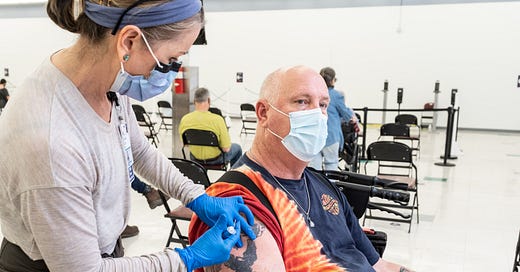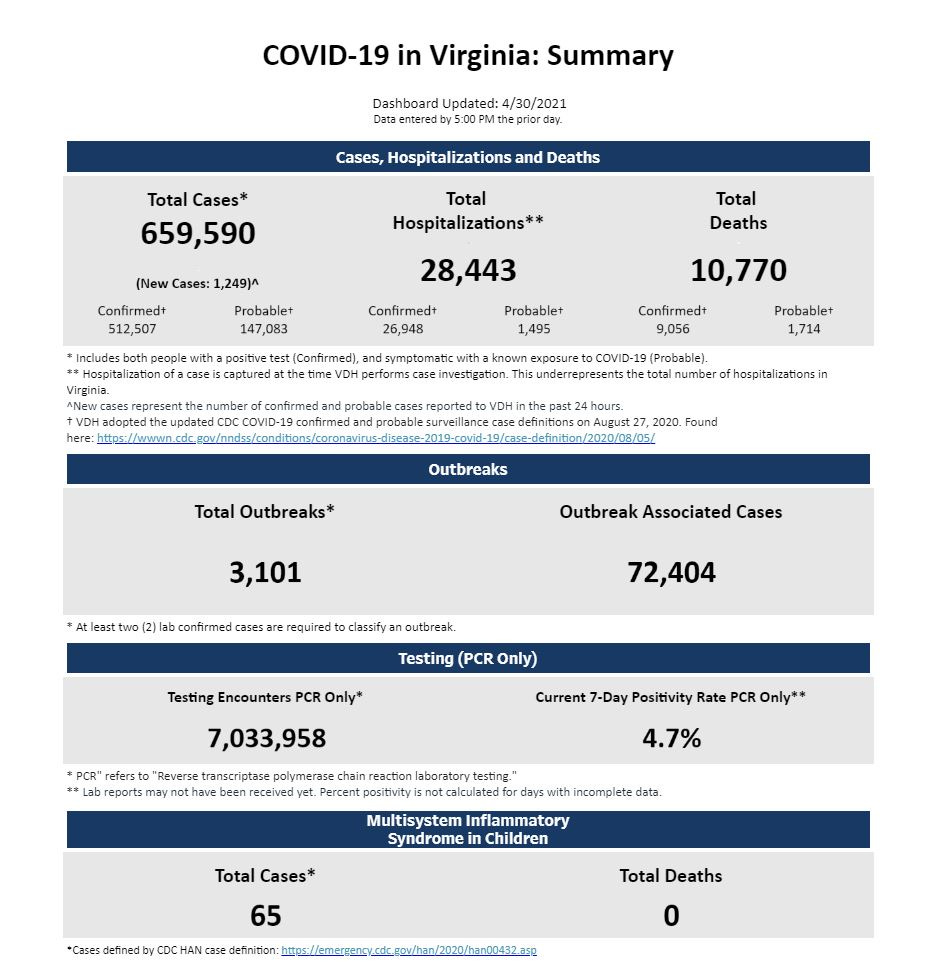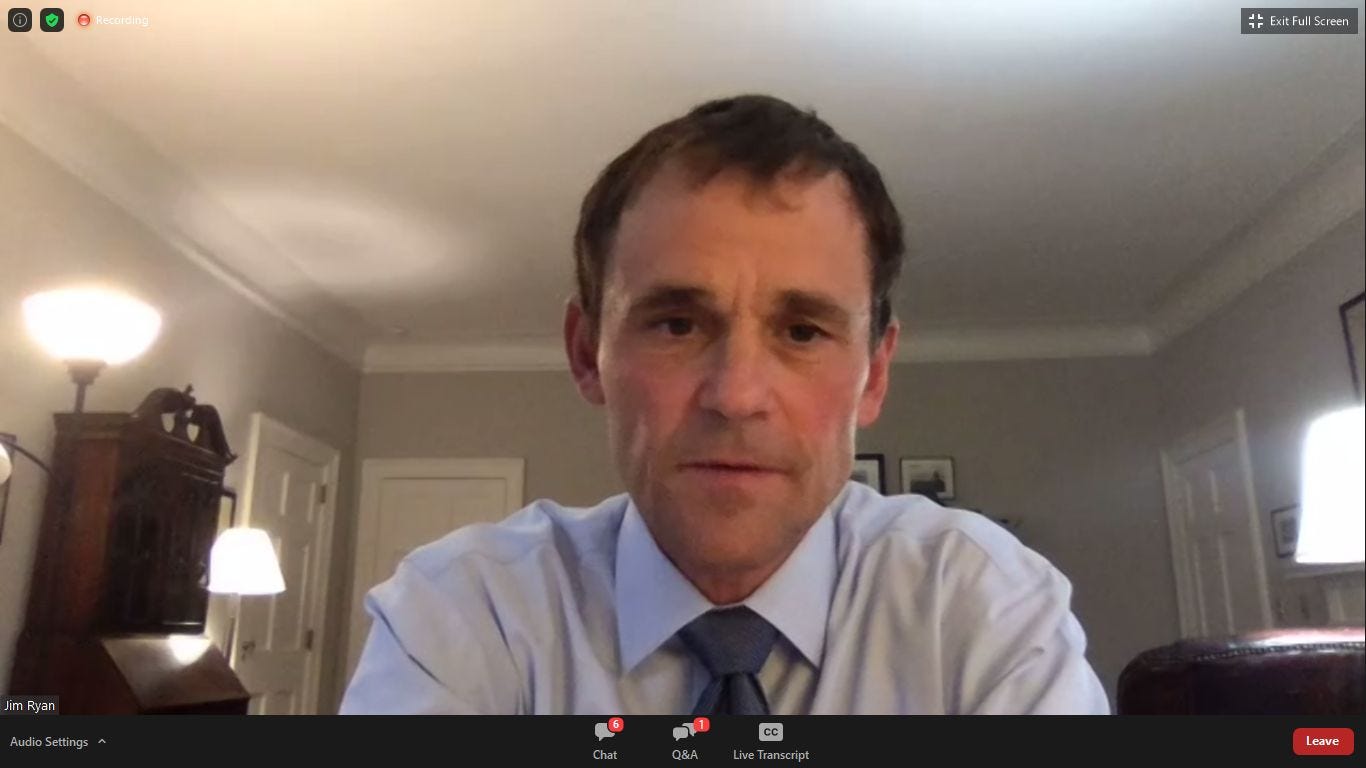In today’s Substack-fueled shout-out, Code for Charlottesville is seeking volunteers with tech, data, design, and research skills to work on community service projects. Founded in September 2019, Code for Charlottesville has worked on projects with the Legal Aid Justice Center, the Charlottesville Fire Department, and the Charlottesville Office of Human Rights. Visit the Code for Charlottesville website to learn more, including details on three projects that are underway.
Today’s installment is just two segments
The University of Virginia details the early days of their initiative to build up to 1,500 affordable housing units on property they control
The latest in pandemic news from the UVA Health System
Yesterday, the University of Virginia Health System administered the 100,000th shot in its effort to assist the Blue Ridge Health District with community vaccinations. In all, UVA Health has helped 42,800 people become vaccinated against COVID, initially at a location in a hospital but for the past two months in the Seminole Shopping Center run by the Great Eastern Management company. The 100,000 dose happened at what’s become known as Big Shots.
As of this morning, the Virginia Department of Health reports that 30.6 percent of Virginians are fully vaccinated, and those numbers are higher in the Blue Ridge Health District. Dr. Costi Sifri, the director of hospital epidemiology at UVA Health said there’s a lot more work to do.
“We think that there’s still many, many people left to be vaccinated,” Dr. Sifri said. “It’s only been two weeks since vaccinations were open to everybody.”
Wendy Horton, chief operating officer for UVA Health System said the next step is to encourage people to get the vaccine.
“We do have supply now and so I think it’s encouraging others and addressing vaccine hesitancy,” Horton said.
Another step will be to prepare to vaccinate younger people when the age limit for vaccine doses drops below 16. Dr. Craig Kent is the medical director of the UVA Health System.
“The goal is to get to whatever that percent is that reaches herd immunity so the higher percentage of folks that are vaccinated, the less likely we are to have continued problems with the pandemic,” Dr. Kent said.
But what is that percent? Dr. Sifri said there is not an agreed upon number and there won’t be an on/off switch. Let’s hear him at length.
“And the reason for that is that there’s a lot of variables that go into what constitutes herd immunity, and it’s probably even reasonable to take a step back and say what is herd immunity. I think the way we most often use that term is sort of when do things look like they’re back to normal where we’re doing the same types of things we were doing before the pandemic or maybe with just some minor modifications. And I think that’s a reasonable definition of herd immunity.”
“Whereas I think maybe in some other contexts we would think about herd immunity being a situation where there’s no more virus, that there’s no more transmission. I think that latter part is something that’s going to be difficult. We don’t know some of the factors that go into this. One the virus is changing, becoming more transmissible with some of these variants. The second is that we don’t know how long the vaccines will provide us protection. They appear very robust at six months and based on that trajectory we think they’re going to be much longer than that. And the third component of this is that there are some people, probably around ten percent that have some level of immunity based on prior infection.”
Today the Virginia Department of Health reported another 1,249 new cases of COVID and the seven day average is 1,038. The seven-day average for positive tests is at 4.7, a figure that has not been that low since mid-October.
But think for a moment about India, which is experiencing a nightmare third wave that is seeing an unbelievable number of cases and a health care system in absolute crisis. Yesterday there were 379,257 new cases reported and 3,645 deaths. The actual numbers are expected to be much higher. Dr. Sifri said he has been in communications with others involved in the global effort to help.
“This is such a dire situation and some of the advice we can provide is important but I think what is really needed is large, institutional, governmental and non-governmental assistance to India,” Dr. Sifri said. “I think it’s a tragedy and it’s something that we our hearts are pouring out for what’s occurring there.”
Dr. Sifri said the experience in India is a cautionary tale for the rest of the world to not lift restrictions prematurely.
“We’re not done with this virus,” Dr. Sifri said. “We’re not done with this virus world-wide. The United States, and I would include our community, need to be partners to turn the tide on this pandemic world-wide.”
You’re reading Charlottesville Community Engagement. Thanks! If you’re interested in supporting the public policy research that goes into this community resource, there are ways to do so financially. In addition to a Substack subscription, there’s also a Patreon account that helps cover the cost of the business, Town Crier Productions. I’m nine and a half months into this experiment, and through Patreon you can get additional behind the scenes audio, or help promote a nonprofit through a shout-out. Thanks to all of those who are supporting me so far, and if you can’t, this newsletter and podcast will remain free as long as I’m able to continue publishing it.
The University of Virginia has begun planning work to implement their pledge to build up to 1,500 housing units to be designated for people at certain income-levels on land owned by UVA or the UVA real estate foundation. At a virtual event Thursday night, President Jim Ryan said housing is one of five areas identified for community partnership. The original announcement of the UVA housing initiative was made on March 10, and the news was quickly overshadowed by the World Health Organization declaration the next day of the COVID pandemic.
“So, a year later I’d like to begin by restating our goal upfront, and the goal is really simple,” Ryan said. “It’s to support the development of a thousand to 1,500 of affordable housing units across Charlottesville and Albemarle County over the next ten years. We’ll do this by contributing land and partnering with a third-party developer. I will say that financial profit is not at all our driver and that our goal has the support of the Board of Visitors and the entire leadership team at the University.”
In the past year, Charlottesville City Council has adopted a new affordable housing strategy. The Albemarle Planning Commission has a public hearing next Tuesday about the update of the county’s policy. And the Central Virginia Regional Housing Partnership has been holding a speakers’ series on views from the development community.
UVA’s work will happen in that regional background, as UVA steps into a role they’ve not played before. Chief Operating Officer J.J. Davis is serving as chair of the UVA Affordable Housing Advisory Group which includes community members.
“The goal for this initial phase of this work is to learn more about how you see the University contributing to affordable housing solutions in our community and to collect input that will help this stage,” Davis said.
(visit the Working Group’s website to watch the video and learn more)
No sites have yet been determined for where new units might be. A quick look at area GIS records shows that the UVA Foundation owns around three dozen properties in Charlottesville, and that the Rector and Visitors of the University own around 90. UVA-proper owns over 70 parcels in Albemarle and the foundation owns several dozen.
To sort through the possibilities and to establish criteria for hiring that third-party developer, UVA has hired Gina Merritt of Northern Real Estate Urban Ventures to work through this phase, which will result in the development of a “request for proposals.”
“My team’s role in the University’s affordable housing initiative is to help UVA to develop a framework for implementing this initiative,” Merritt said. “The University plans to solicit developers to help develop University property in a way that meets our collective goals.”
This will include market research, review of previous studies, and discussion of comparative examples.
“And once the sites are selected for development, we will evaluate zoning, determine what housing and income types should be located on each site, and then draw diagrams to show the potential scale of these buildings,” Merritt said. “We will run financial models to determine the best way to finance the development and identify possible resources to fund the project.”
Merritt presented three examples of developments she’s been involved with. One of these is the 70-unit Nannie Hellen at 4800 in Washington D.C. where one-third of the units were replacement units for public housing, and the rest were financed through Low-Income Housing Tax Credits (LIHTC).
The trio took questions from those on the virtual call. J.J. Davis asked the first.
“A lot of organizations are already doing affordable housing work,” Davis asked. “Where will UVA fit in so that they are not competing or duplicating efforts. Jim?”
“That’s a great question and in some respects that’s part of the community engagement process,” Ryan said. “The landscape is filled with people who are working on this issue already and we want to figure out the best way we can fit into this landscape so that we’re not duplicating efforts or competing but instead complementing the efforts.”
“Next question,” Davis asked. “When will the units be built?”
“Well, we want to get started as soon as possible,” Ryan said. “As I mentioned earlier, the goal is to complete a thousand to 1,500 units over ten years. Our thought is that we will start with one project. We are not that experienced with this so what we want to do is start with one project and take the lessons we’ve learned there when we move on to the second or third projects.”
Near the end of the presentation, Merritt took advantage of the poll feature in Zoom to take the pulse of those attending. Nearly ninety percent of those participating supported the idea of UVA developing housing for the community on its property.
President Jim Ryan concluded the event.
“UVA and our neighbors in Charlottesville, Albemarle, and the surrounding counties are linked together and our fates are tied together and one of the reasons for us to be a good neighbor is because of that. I think helping to contribute to… increasing the supply of affordable housing is one part of that,” Ryan said.
We’ll be sure to be covering this in the day, week, months and years to come.
To ensure that:
Support my research by making a donation through Patreon
Sign for a subscription to Charlottesville Community Engagement, free or paid
Tell others to help us all grow the audience!

















Share this post